|

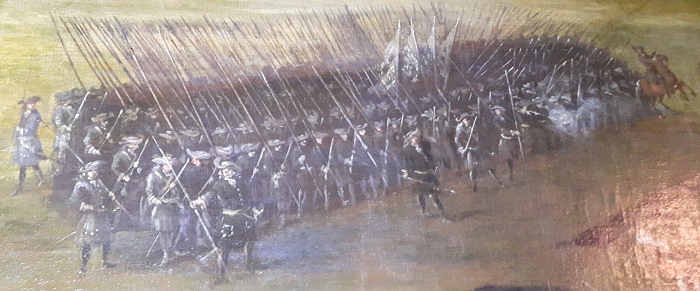
A Swedish battalion in the battle
of Düna painted by Daniel Stawert.
The uniform worn by the Swedish soldiers in the Great
Northern War is the most iconic in Swedish history and is commonly referred
to as the “Carolean Uniform”. In the popular imagination it consisted of a
tricorne hat, a knee long blue coat with yellow turnbacks, collar and small
cuffs together with yellow breeches and knee long stockings. Furthermore,
the coat would have horizontal pocket flaps with five corners and up to
seven buttons. This is the classic appearance of the Carolean uniform and
it is usually the one shown in modern illustrations.
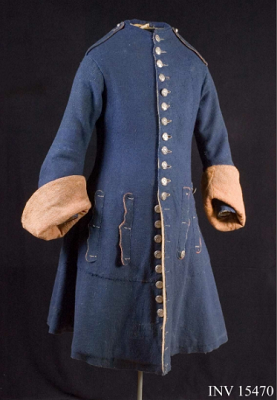
The so called "Older Carolean
Uniform" which probably
never
saw widespread use |
However, a long held opinion in uniformology has been
that there were two distinct Carolean uniforms, separated by the year 1706,
and that only the younger uniform looked like the classic Carolean uniform.
The older uniform had a coat with no collar, large cuffs, and double
vertical pocket flaps on each side. The basis of this claim is a preserved
coat in the Swedish Army Museum which is dated to the late 17th
century. The only other preserved coats are from the Norwegian campaigns of
1716 and 1718, worn by Charles XII, his brother-in-law Frederick of Hesse
and lieutenant Drakenhielm (the latter might however be a recycled coat from
the 1690s and is conspicuously missing a collar). This view is presented as
a fact in Erik Bellander’s book “Dräkt och uniform” from 1973, which
is the major work of reference for the evolution of Swedish uniforms. But
since then more research has been done on this topic, casting doubts on the
theory of an older and a younger Carolean uniform.
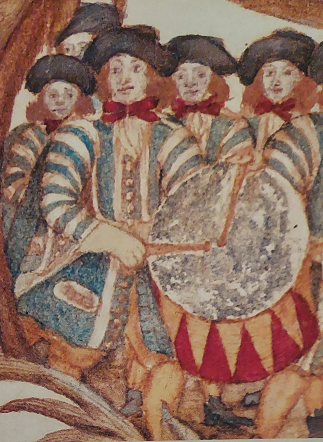
Nyland drummers from 1696
who neither wear the "Older"
or the "Younger" Carolean
uniform. Contrary to the
picture, Swedish drums
usually had the same motif as
the colours. |
The most extensive research of Carolean uniforms has been
done by Lars-Eric Höglund and unlike the more general approach of Bellander
his work covers each individual regiment in the army. He has gradually
abandoned the traditional theory of the so called “Older Carolean Uniform”
being in use until 1706. The first version of his uniform book (in Swedish)
was published in 1995, with an English translation the following year. In
that book he argued that the older uniform must have been abandoned already
in the early 1690s because of all the modern features in uniforms from that
time. To cover the resulting time gap he proposed to introduce the concept
of a third Carolean uniform type (the intermediate Carolean uniform) which
according to him evolved into the younger uniform which he still dated to
1706.
However, Höglund’s view had changed even further when he
later began to publish uniform books covering Sweden’s opponents. These
consisted of two volumes in Swedish from 2003-04 which were then published
in a combined volume when it was translated to English in 2006. In the
preface to the first of the Swedish volumes, Höglund noted that an old
illustration from 1696 contained a picture of drummers from Nyland regiment
who clearly were not wearing the uniform issued to them in 1696. Hence it
had to be the one which had been issued to them in 1688. But the uniform did
not look like the so called Older Carolean Uniform, instead it looked like
the uniforms worn in the Scanian War 1675-79. Höglund’s conclusion was that
the preserved coat in the Army Museum most likely was a rejected prototype
and that the Swedish army continued to use the Scanian War type uniform
until it was replaced by the classic Carolean Uniform in the 1690s.
The Coat
Before the Swedish army adopted the Carolean Uniform they
wore the uniform used during the Scanian War 1675-79. Its main component was
the “justaucorps”, a knee-long coat of French origin which spread to all of
Western Europe during the latter half of the 17th century and would then be
the dominant fashion for well over a century. It came to Sweden c. 1670 and
replaced the older jackets, which originally had ended at the waist although
they too had gotten quite long at the time the justaucorps arrived. The
Carolean coat would evolve from this early justaucorps, with most of the
changes intended to make it more suitable for campaigns rather than to
imitate civilian fashion.
The main differences between the Scanian War coat and the
classic Carolean coat were the former’s larger cuffs, no collar, no
turnbacks and rectangular pocket flaps. The pocket flaps were however in
both cases horizontal so in that regard nothing changed, if indeed the
preserved Army Museum uniform was just a rejected prototype. The Scanian
War coat also had “edges” (lace) in the facing colour. The row of buttons on
the front covered the entire length of the coat until 1706 when they were
supposed to end at the waist. But even in the 1670s there were no
buttonholes below the waist so those buttons were just decorations.
These changes may however have been implemented gradually
and frequent regimental variation makes it even more difficult to point to a
certain date as the “birth” of the Carolean Uniform. The Guard had for
example collars already in the 1670s. The traditional date of 1687 is
nevertheless still useful since the most visually striking change was
implemented that year. On 29 May 1687 Charles XI ordered that all infantry
colonels should be sent letters with blue cloth samples, declaring that
their regiments henceforth should dress their regiments in coats with that
colour (and in most cases this also meant yellow facings).
The Scanian War uniforms had come in all kinds of colour
combinations. Rather than having a national colour common to all regiments,
Sweden had decided in a regulation from 1675 to give each regiment a
distinct colour combination, often inspired by their provincial coat of
arms. This regulation was still in use immediately after the war when new
uniforms were issued to all regiments. Since the uniforms of provincial
regiments saw very little wear and tear during peace time, this set of
uniforms would be in use for a whole decade. It was when these post-war
uniforms were due to be replaced that Charles XI ordered the change to blue
coats in 1687.
A record from 1683 show that the contemporary uniforms
still were of the Scanian War type. The coat was supposed to consist of 4
ells cloth (with a width of 2.25 ells) in the regimental colour and an
additional 0.5 ell cloth to cuffs and edges. A Swedish ell was 0.593804
metre long.
The first generation of Carolean uniforms (issued
1688-1694) had the same amount of cloth as the earlier uniforms but less of
it seem to have been allocated to facings, which is down to about a 0.25 of
an ell. This reduction might have been caused by the disappearance of
decorated “edges” on the uniforms. Collars were however planned for
Björneborg’s uniforms in the early 1680s and they were included in the coats
issued to the Dal-regiment in 1690 and for Nyland regiment in 1696 so it is
thus plausible that the “edges” were directly replaced by collars when the
new Carolean uniforms were issued. Although when Jönköping regiment was
issued new uniforms in 1692 only the corporals were given collars. In any
case, a document from the year 1700 clearly states that all infantry coats
were to have collars
Another cause for the reduction of cloth allocated for
facings is likely the introduction of the most distinctively Swedish feature
of the Carolean uniform, namely the small square size cuffs. Civilian and
international fashion dictated very large cuffs, but these were highly
impractical when soldiers handled their weapons, so Charles XI insisted that
his army should have small cuffs. While the privates’ uniforms generally
conformed to the King’s demand, the officers proved more reluctant.
Officers’ uniforms were not issued by the Crown so they had to acquire them
with their own money and many bought coats with cuffs of a more fashionable
size. Several illustrations from this time also depict officers with much
larger cuffs than those worn by the men they commanded. Charles XI, however,
did not look kindly to this and complained to the colonel if he saw large
officer cuffs when he mustered his troops.
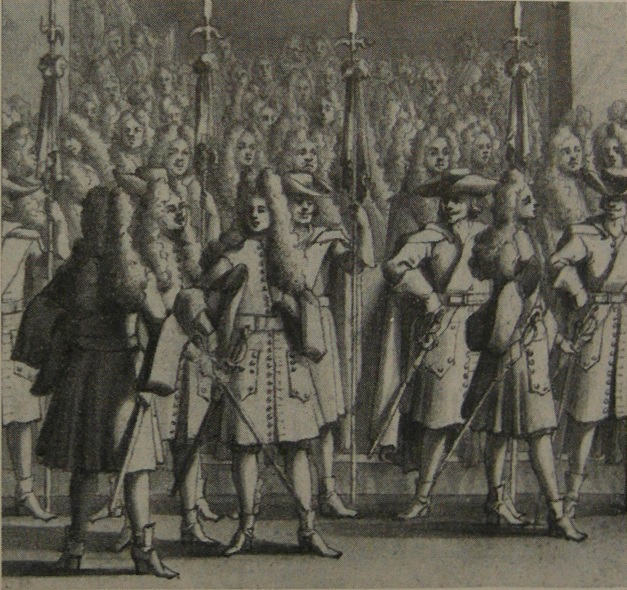
The Guard 1693 (note the large
cuffs on the officers)
Despite the officers’ reluctance, the general trend
appears to have been that the size of cuffs shrank in size over time. Battle
paintings illustrating the Scanian War usually do not depict the very big
cuffs found in the original French fashion but cuffs of a more moderate
size. If we assume that the length of the cloth allocated to facings equals
the length of the cuffs, then the Dal-regiment was issued 22.26 cm (3/8 of
an ell) long cuffs in 1690. This was however most likely unusually large
cuffs while Närke-Värmland’s 14.85 cm (1/4 of an ell) was probably standard
at this time. The latter size is also repeated for Jämtland regiment in
1710. But Södermanland was issued 11 cm (1.5/8 of an ell) long cuffs in
1702. And Kronoberg was issued 7.4 cm (1/8 of an ell) long cuffs in 1718
which is also the same size as the cuffs on Charles XII’s preserved uniform
from the same year. The uniform lieutenant Drakenhielm wore when he died in
1718 have however 12-13 cm long cuffs, though as previously stated it might
have been a recycled coat from the 1690s.
Other than size, Swedish cuffs also differed from the
more fashionable international cuffs in the way which they were fastened on
the sleeves. They were not fastened with buttons and instead sewn on to the
sleeves. The backside of the Swedish cuff may have had a slit which enabled
the soldier to reach three small buttons at the end of each sleeve. This was
at least the case for the Guard and the three preserved Carolean uniforms

David von Kraffts painting from 1706.
The text in the corner states: "King Carl the
XII such dressed as when he went on his
campaign Anno 1700". |
Another distinctive Swedish feature on the coat was the
early adoption of turnbacks. Exactly when this happened is however not
known. The cavalry is depicted by the painter Johann Philipp Lemke
(1631-1711) to occasionally wear turnbacks during the Scanian War, although
those paintings are probably anachronistic. A picture from 1696 does however
show cavalrymen from Nyland Regiment with turnbacks. Later some cavalrymen, but none of the
infantry, are shown with turnbacks in illustrations by Daniel Stawert (died
c. 1711) and Johan Lithén (1663-1725) of the battles of Narva and Düna,
which were made not long after the events occurred. Hooks used for turnbacks
are also noticeably absent in the detailed specifications of the materiel
used for uniforms to Södermanland infantry regiment, Swedish Life Regiment
on Foot and the Pomeranian Cavalry Regiment in 1700-02. But the cavalrymen at
Södra Skånska were instructed to turn back their coats in 1702. The evidence would
thus suggest that Swedish soldiers in general did not wear turnbacks in the
early years of the war, at least not the infantry. Erik Bellander has
however suggested that there likely was a transition period during which the
soldiers on occasion had their coats turned back for practical reasons (such
as riding, marching and fighting) but otherwise wore them as fashion
dictated until turnbacks became a permanent feature of the uniform. A
possible date for the latter could be 1706 when Charles XII ordered that
there should be no buttons on the coat below the waist. Since these buttons
had been mere decorations from the very beginning, the permanent adoption of
turnbacks would have made them completely redundant. Also noteworthy is that
a famous painting of Charles XII was made in 1706 with the usual turnbacks
on his coat. The text on that painting explicitly states that it shows how
Charles XII was dressed when he was on campaign in 1700.
The year 1706 has traditionally been the date for the
birth of the “Younger Carolean Uniform”. This is because of the above
mentioned letter which not only ordered the reduction of the buttons, but
also declared that the uniforms should be wider. The latter meant increasing
the amount of cloth from the usual 4 to 4.5 ells to as much as 5.5 ells per
coat. The extra amount of cloth would have been used to increase the number
of folds on the lower part of the coat, thus enabling the “bell shape” of a
true justaucorps. 5.5 ells was the amount of cloth an NCO of the Guard was
required to have already in 1699. Officers and NCOs generally had coats that
were not just of better quality but also consisted of more cloth. However,
as far as the privates are concerned there is nothing that suggests that the
increase to 5.5 ells cloth was a permanent one. In all likelihood Charles
XII just took advantage of the fact that his new luxurious uniforms in
1706-07 were paid for by generous contributions from the Saxon tax payers.
When the Swedish army had to be restored after Poltava the new uniforms had
the same dimensions as before 1706. The only lasting change was the buttons.
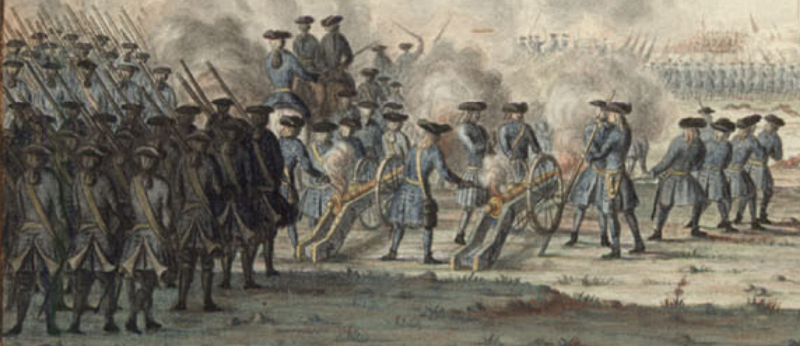
Swedish troops in the battle of Gadebusch painted by Magnus Rommel
Buttons
Throughout this time period the number of buttons on the
coat varied, although the general trend was that they decreased. The
Scanian War coat generally had just 30-32 buttons, but the Guard decorated
their coats with as many as 48 buttons. From 1680 to 1699 it was regulated
that Guard coats should have just 36 buttons and this was also the number
that was used when the first Carolean uniforms were issued to the provincial
regiments c. 1690. At least two regiments decided however that 36 buttons
were not enough. Närke-Värmland’s coats (worn until 1705) had 42 buttons and
the Dal-regiment’s coats (worn until 1701) had 48 buttons.
From 1699 Guard coats were regulated to have just 26
large buttons and six small ones (the latter were for the sleeves). The
regular regiments may have suffered greater reductions as three of them were
issued coats with 30 buttons in 1702. Furthermore, a cavalry coat for the
Livregemente was to have 24 buttons in 1706 and about the same time an
infantry regiment (de la Gardie’s) was to have just 21 buttons.
After Poltava, even the restored Guard was issued coats
with just 19 buttons, the same as the restored Adelsfana regiment. The Guard
would later have their button count increased to 24 large buttons and six
small ones when Charles XII returned to Sweden (regulation of 1716). And at
least two regiments were issued coats with 21 buttons (Jämtland in 1710 and
Västgöta 5-männings in 1712). But Kronoberg regiment was issued coats with
just 18 buttons in 1714.
The reason for the reduction of buttons could be
economical, especially after 1709, but the decision in 1706 to not have
buttons below the waist was probably due to fashion (permanent turnbacks?)
and must account for a very large share of the reduction. A specification of
where the buttons were located can be found for the Guard in 1707:
|
11-12
1
3
3 |
on the front, depending on the length of the soldier
on each side (of the waist)
on each pocket flap (5 for corporals)
(small) at the end of each sleeve |
All in all this meant 19 or 20 large buttons and six
small buttons. This was less than the 1699 regulation required, but that is
likely caused by the 1706 decision to eliminate buttons below the waist.
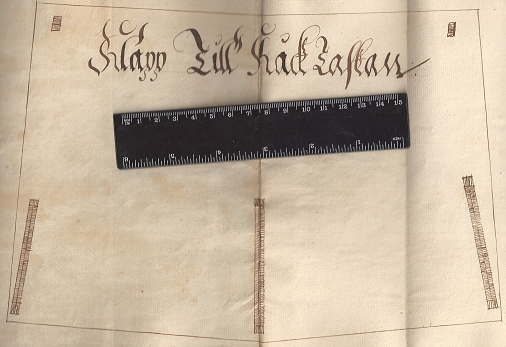
An instruction from 1709 that shows how the Adelsfana's
pocket flaps with three buttons should look like. (A ruler has
been added to the photo which shows that thepocket flaps
should be 24 cm wide at the top and 18 cm high in the middle) |
Note that this specification makes no mention of buttons
for shoulder straps. The three preserved Carolean coats did not have
shoulder straps either. The Adelsfana uniform of 1709 did however have one
button allocated for a shoulder strap intended for the carbine belt, so this
might have been standard for cavalry uniforms but not for the infantry.
The fact that guardsmen should only have three buttons on
each pocket flap is also noteworthy because modern illustrations usually
depict Carolean pocket flaps with seven buttons. The fact is that there is
no reference for private soldiers to have been issued anything but three
buttons on their pocket flaps during the Great Northern War. The
Livregemente (in 1700) and the Adelsfana (in 1709) are also reported to have
had just three buttons. Regulations from 1727 and 1729 state however that
cavalrymen and dragoons should have five buttons on their pocket flap, but
that were in the post-war era.
The reason for the seven buttons misconception is that
all three preserved Carolean coats have that number of buttons on their
pocket flaps. But those coats belonged to royalties and officers and are not
representative for private soldiers. The number of buttons on the pocket
flaps was clearly an indication of rank and an illustration from 1693 show
how the various ranks of the Guard were distinguished at that time:
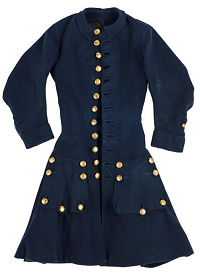
Charles XII's coat from 1718
One pocket flap is missing a
button |
9 buttons for officers
7 buttons for NCOs and private drabants
5 buttons for corporals
3 buttons for private guardsmen |
For at least the latter two categories this arrangement
was still in effect for the Guard in 1707. And we also have examples from
other regiments where the total number of buttons for the coat differed
between ranks. Närke-Värmland’s coats from the 1690s had 42 buttons for
privates and 54 for corporals. The Dal-regiment had at the same time 48
buttons for privates and an astonishing 96 buttons for NCOs and officers!
Portraits of officers who fought in the Great Northern
War show us that they could have anything from three to twelve buttons on
their pocket flaps. Apparently the regimental variation was great and we
cannot assume that the seven button pocket flap worn by Charles XII, his
brother-in-law and lieutenant Drakenhielm represented a widespread standard
for showing an officer’s rank.
Besides counting buttons, the illustrations from 1693 are
also interesting because they depict the classic Carolean Uniforms’s
horizontal pocket flaps with five corners, thus implying that they were
included from the very beginning.
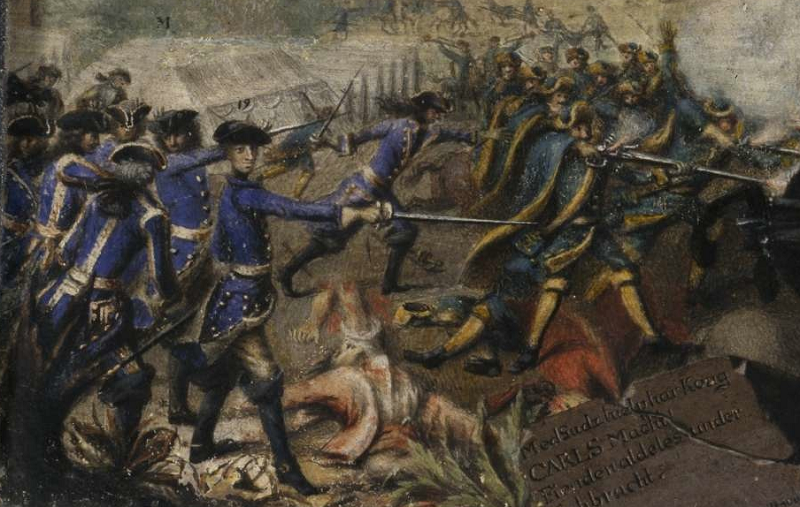
Drabants with hats and Uppland
grenadier with karpus in the
battle of Düna painted by Johan Henrik Schildt
Headgear
|
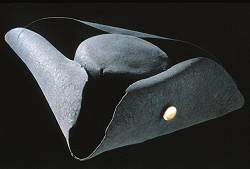
Charles XII's hat from 1718. |
The Swedish army had two basic types of headgear, either
the hat made of felt or the “karpus” which was a cap with flaps and usually
made of cloth. Both types had coexisted in the Swedish army even before the
introduction of the Carolean uniform and would continue to do so throughout
the Great Northern War. The former was at first a wide brimmed hat which
then evolved into a tricorne. Exactly when this transition occurred is not
known since written sources do not distinguish between these two hats. The
transition is also obscured by the fact that the karpus was the most widely
used headgear when the hat fashion changed.
The karpus became much more common after the end of the
Scanian War, and when the Swedish provincial regiments received their first
Carolean uniforms in the late 1680s and early 1690s they appear to have been
exclusively issued the karpus. The great advantage with this type of
headgear was that it was well suited for the cold Swedish climate, with the
men being able to pull down the flaps to protect their ears. The downsides
were that it was more expensive and that it likely was viewed by many as a
form of peasant clothing unbecoming of soldiers. The latter point is
strongly implied by the fact that officers continued to wear the more
fashionable hats even when their privates were issued karpus. Already in
the late 1690s a move back to hats is noticeable among the cavalry
regiments, which were soon to be followed by the infantry in the early years
of the war. Enlisted regiments also seem to have had little interest in the
karpus throughout this time period.
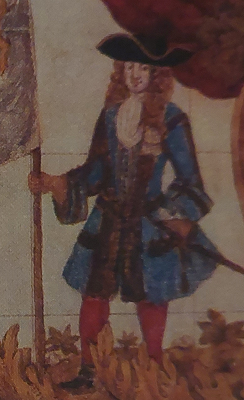
Officer from Tavastehus Regiment
1696 who might be wearing a tricorne.
His cuffs are large though. |
In the early battles of the Great Northern War all
Swedish infantry regiments wore karpus, with the only exceptions being the
Guard and newly raised 3-männing regiments. But when the Russian campaign
started in 1707 all Swedish regiments in the main army wore hats, with
Västerbotten regiment being the only exception. The karpus did continue to
be issued to regiments in the latter half of the war, but it was by then a
much rarer sight. The distribution of the two types of headgear also had a
clear geographical pattern in that it was the northern regiments who were
the last to abandon the karpus.
The earliest illustration of what
looks to be a Swedish soldier wearing a tricorne hat is from 1696 and it
depicts an officer of Tavastehus regiment. Later two separate sources, a
painting of a member of the Princess’ drabant corps in 1704 and a manual
from 1705 with drawings of artillerymen, clearly show them wearing
tricornes. But paintings of the early battles of Narva and Düna by Daniel
Stawert suggest that the hats were still in a transition phase then with
many different styles of hats in use. Some have hats with three sides folded
up, but usually there were just two sides folded up although this was done
in many different variants. Many hats had for example two sides folded up so
that it looked like a tricorne from the front but like a wide brimmed hats
from the back. After Düna there is no contemporary battle painting showing
these details until Magnus Rommel (1678-1735) illustrated the battle of
Gadebusch, and he depicts the entire army wearing tricornes.
There was also a third type of
headgear in the Swedish army, namely the grenadier cap. That was however a
very rare sight since Swedish grenadiers generally did not wear those. Of
well over a hundred infantry units only thirteen are known to at some
point in time have worn grenadier caps during the Great Northern War.
There actually was a proposition put
forward in 1700 to equip the grenadiers with caps just like the Dutch and
German armies did, but Charles XII rejected it.
Obviously there was no ban against grenadier caps in the Swedish army, but
any colonel who wanted to equip his soldiers with those had to pay for them
with his own money.
The first reference of Swedish grenadier caps is from 1691 when the
Dal-regiment purchased a set. But as previously mentioned the Dal-regiment
distinguished itself during the 1690s by having very extravagant uniforms.
Nevertheless, when the regiment increased its number of grenadiers by 50 %
in 1693 the new grenadiers had to wear the karpus since no additional
grenadier caps were purchased.
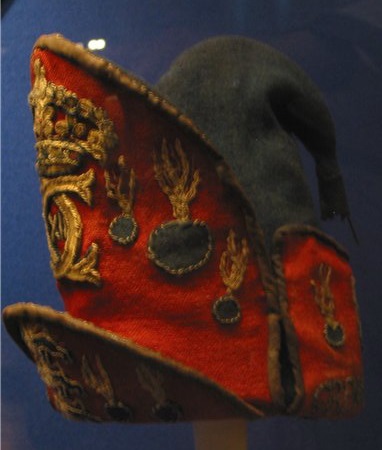
The correct appearance of
the
grenadier cap from De la
Gardie's Regiment. |
It is not known what the Dal-regiment’s grenadier caps
looked like, but we have descriptions and preserved caps from other
regiments and from these samples it is clear that the variation was great.
There were for example caps completely made of cloth as well as those with a
bear skin brim or a brass plate. Since there was no regulation the design
was completely up to personal taste of each colonel.
The most well-known preserved Swedish grenadier cap
belonged to De la Gardie’s regiment and it was taken by the Russians when
Narva fell to them in 1704. This cap is blue with red facings, just like the
uniform of the Narva garrison regiment. Unfortunately misconceptions caused
by black and white photos have led to more than one illustration with
incorrect colourations. One of these can be found in a colour plate in the
Osprey campaign series book on the battle of Poltava where a large part of
the front is incorrectly blue. The Osprey book has also incorrectly depicted
the grenadier as wearing a blue coat with yellow facings instead of the red
facings found on the cap. This particular mistake has since then
regrettably been copied by several other illustrators and painters.
Hair
Swedish soldiers were since the 1680s required to wear
their hair in a black pouch. The only exception being the artillery which
could let their hair hang free. This regulation would remain in place until
the 1720s when it was replaced by the Prussian inspired soldier's queue, or
pigtail as it is also called. This change in hair fashion would be the only
distinctive feature that separated the appearance of Swedish soldiers in the
Great Northern War from those in the Seven Years War four decades later.
Paintings do show however that despite of this soldiers did not always have
a hair pouch. Furthermore, two officers wearing a queue can be found as
early as in the illustration of the battle of Gadebusch made by Magnus
Rommel.
Neckcloth
The neckcloth was originally tied at the front with a
separate and different coloured ribbon to form a cravat. But in the late
1690s this changes into the Great Northern War practice of tying the
neckcloth behind the neck. The ribbon used to tie the neckcloth disappears
at the same time and interestingly the Guard was in 1697 permitted to use
the money previously spent on those ribbons for acquiring hat lace instead.
The colour of Swedish army neckcloths was originally
black but Charles XI did not like that colour and the first Carolean
uniforms saw much diversity in colour choices between the regiments. At the
end of the 1690s however, the black colour came back and together with white
they were to be the dominant neckcloth colours in the army during the Great
Northern War, even though other colours still occurred.
An overview of Swedish neckcloth colours for each
regiment can be found in this page.
Piecoat and Cloak
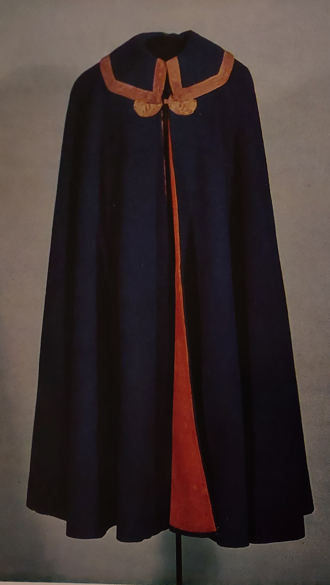
An officer
cloak with gold
lace from the reign of
Charles XI. |
When the first Carolean uniforms were issued around the
year 1690 an overcoat called piecoat was included. This item was usually
made of grey “vadmal” (coarse wool) with blue facings and was used
both to keep the soldier warm and to protect the regular coat from bad
weather. But Charles XI decided already c. 1692 that the soldiers should be
issued cloaks made of cloth (usually blue with the collar and lining in the
regimental colour). Since the cloak had the same function as the piecoat,
this had the effect that the cloak soon replaced the piecoat altogether.
Drummers would however continue to wear the piecoat throughout the period.
The piecoat made a brief comeback among privates after Poltava when almost all of the restored
infantry regiments appear to have been issued this instead of the cloak
(only Västmanland is known to have received cloaks). This measure was taken
for economic reasons and later in the war several of these regiments are
known to have had cloaks again.
While other reforms of the Swedish uniform during this
time period served the purpose to make them more suitable for military use,
the wide scale adoption of cloaks seem to have been motivated by aesthetics
rather than functionality. The colonel of Västerbotten regiment wanted in
1696 to get rid of them by stating that his soldiers had too many items of
clothes to carry on the march and that the cloak took longer time to dry
than the piecoat. He did however acknowledge that the cloak did much to
increase the stature of the soldiers while on parade, although he claimed
that this was only needed for soldiers garrisoning cities where foreigners
could see them. The king was however not convinced by this complaint and the
cloak would remain a part of the Carolean uniform.
"Släpmundering"
Another grey vadmal coat issued to the Swedish
soldiers was a part of the outfit that was called “släpmundering”, a
term that could be translated to “work-clothes”. The regular uniform was
called “livmundering” and the army took great lengths to avoid
unnecessary wear and tear to this uniform. For example, provincial soldiers
had to keep their livmundering sealed in coffins during peace time
and be subjected to regular inspections of their condition. They were only
allowed to wear the livmundering during the annual regimental drill
(not even during the monthly company drills). So when soldiers had to do
tasks that posed a risk of getting their cloths dirty or even ruined, then
they wore their släpmundering in grey vadmal instead.
Grey vadmal (= undyed coarse wool) was a much
cheaper material since it cost less than half of the blue cloth. So when the
Swedish army had to be restored after Poltava, the Defence commission
considered to issue grey vadmal coats instead of a proper “livmundering”
in order to save money. They relented however after hearing numerous
objections accusing such a move to be counterproductive because blue cloth
was more durable than vadmal, also better for preserving the men’s
health and better for their moral since it meant that their uniforms would
distinguish them from ordinary peasants.
|
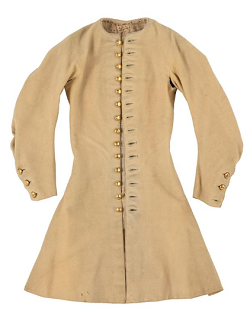
Charles XII's vest
from 1718 |
Nevertheless, there are numerous examples of regiments
being issued only a släpmundering and not a livmundering
during the Great Northern War. For example the first uniforms issued to the
newly raised 3-männing infantry regiment were all in grey vadmal. The
Swedish state finances during the war were anything but good so compromises
had to be made.
Vest and Breeches
Underneath the coat a vest was worn which despite the
modern meaning of that term actually had sleeves. The vest was together with
the breeches usually made of leather. Like in other armies a transition from
leather to cloth can be noticed in the Great Northern War. The uniforms of
the 1690s had these items almost exclusively made of leather while cloth
became more common after the outbreak of the war, although leather would
remain the dominant material in the Swedish army throughout the war.
The upside with leather was that it was a much more
durable material. Cloth was on the other hand more comfortable as it unlike
leather did not take so long to dry after it had been wet.
Stockings, Shoes and Gaiters
The infantry were usually issued two pairs of knee long
stockings in the regimental colour (although each pair could have a
different colour). They were also issued a pair of “marching stockings”
which were usually grey and intended to be used while marching to save the
regular stockings from wear and tear.
|
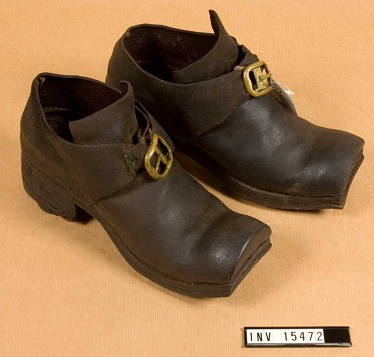
"German shoes" m/1756 |
In a similar fashion the foot soldiers were also issued
two different pair of shoes, a pair of “Swedish shoes” and a pair of “German
shoes”. The latter came with a buckle and closely followed the civilian
fashion. The “Swedish shoes” were also called “marching shoes” and might
properly have been called boots. These were more suitable for marching,
trench work and walking in snow but were of course not as pretty as the
German styled shoes.
A feature on both types of shoes as well as the cavalry
boots was that they did not follow the shape of the foot. The right shoe and
the left shoe had the same shape and ended with a flat vertical front. This
peculiar shoe fashion existed in Sweden from the 1640s to the 1760s but it
is a common mistake among modern illustrators to depict shoes from this
period with a rounded shape.
The Swedish marching shoes were however not enough to
protect the soldiers’ legs from the elements. A precursor to the gaiters
were the so called over-stockings which were pulled over the regular
stockings. Actual gaiters are also known to have been used by several
regiments in the latter half of the Great Northern War.
Cavalry uniforms
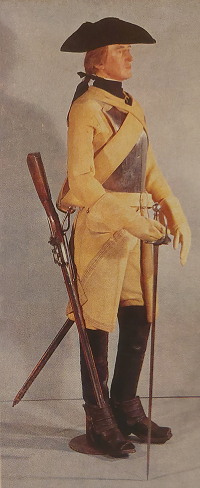
A cavalryman with a
buff coat
and
cuirass but no cloth coat
worn over it. |
The cavalry uniforms differed more
from the infantry than the fact that they had cavalry boots instead of
shoes. They were also supposed to have a cuirass underneath their coat which
meant that it had to be wider than the infantry coat. Although, judging from
some paintings, cuirasses might also have been worn over the coat. In any
case the Swedish cuirasses retained its natural steel colour and were not
blackened for rust protection as was usually done to Swedish sword hilts
(and for Danish cuirasses).
The cuirasses were however not
popular among the men and it was very common that the men “lost” them during
campaign. For example, Södra Skånska regiment reported that they in 1703
only had 354 cuirasses left and in the following year only a handful
remained. The lost cuirasses were replaced though and offenders were
punished, at least in the main army as Charles XII apparently was adamant
that his cavalry should wear them. But elsewhere the enforcement of the
regulation seems to have been less strict. Cuirasses are completely absent
from lists of equipment in Lewenhaupt’s army. And a manufacturer of
cuirasses complained in 1711 that they had not received any commissions in
years, which strongly suggest that the restored regiments after Poltava were
not issued cuirasses. It was not until 1716 that the manufacturer received
new commissions, and this was most likely a result of Charles XII’s return
to Sweden.
Also worn underneath the coat in the early days of the
Carolean uniform was the buff coat (“kyller”) which originally had preceded
the justaucorps as the primary cavalry coat. But as an undergarment the buff
coat was soon replaced with the vest used by the infantry. When war broke
out in 1700 the Swedish cavalry wore their leather vests on campaign and
left the buff coats at home.
While 1687 is commonly referred to as the year when dark
blue became the standard Swedish coat colour, it is worth mentioning that
this at first only applied to the infantry. When the war started only six
of the 14 provincial cavalry units had dark blue coats. The largest and most prestigious, Livregementet, wore
together with Södra Skånska light blue uniforms. All Finnish units as well
as the Adelsfana and Jämtland Cavalry Company wore grey coats. And the Bohuslän Dragoon squadron wore
very distinctive green coats. However, dark blue became the standard colour
for the newly raised regiments and in the early half of the war the older
regiments switched to dark blue as well. The one exception was the Bohuslän
dragoons who successfully resisted these attempts and would remain green
throughout the 18th century.
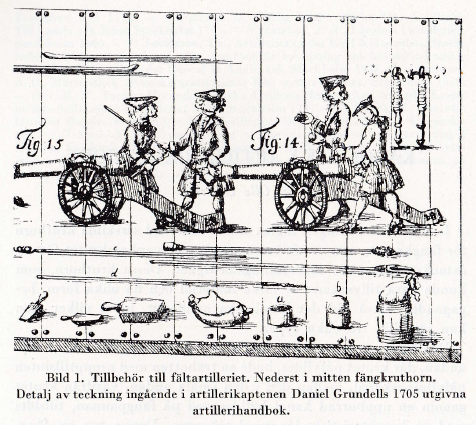
Drawing of artillerymen from 1705 by Daniel
Grundell
Artillery uniforms
The artillery was also exempted from the 1687 reform and
continued to wear grey coats with blue facings until they gradually
transitioned to all blue uniforms during the first half of the war.
They also distinguished themselves by not wearing hair
pouches or turnbacks during the Great Northern War, although they would
adopt them in the 1720s.
Officers and NCOs
As previously mentioned the number of buttons on the
pocket flaps was used to distinguish the different categories of rank in the
Swedish army. Officers and NCOs were furthermore distinguished from the men
by having all blue uniforms and not facings and stockings in the regimental
colour, although this was not the case in all regiments. Officers would have
gold lace on their hats and coats while NCOs had silver lace instead.
However, the cavalry frequently had silver hat lace for the privates (and
occasionally gold lace too) so it was not uncommon for cavalry NCOs to have
gold lace instead of silver.
Unlike the other European armies, Swedish officers did
not wear a sash. Infantry officers and drabants did however wear a gorget as
rank insignia. And just like their cavalry colleagues, infantry officers
were also supposed to have cuirasses (though if they actually did is a
completely different matter).
During the Great Northern War Swedish officers was to
have the following appearance of their gorgets and parade coat in accordance
to their rank (the latter also includes cavalry officers):
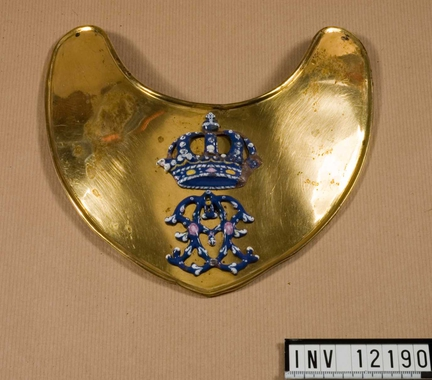
A captain's gorget from the reign of Adolf Fredrik
(1751-1771)
|
|
Gorget |
Parade Coat |
|
Colonels |
Gilded silver with the royal cypher and other decorations (lions?) in
enamel. |
Was allowed to distinguish himself from his subordinates with as much
as he could afford. |
|
Lieutenant Colonels &
Majors |
Gilded silver with the royal cypher and palm wreaths in enamel |
Wide gold lace on cuffs and pocket flaps. Buttons and buttonholes
decorated in gold. |
|
Captains |
Gilded silver with the royal cypher in blue enamel |
Narrow gold lace on cuffs and pocket flaps. Buttons and buttonholes
decorated in gold. |
|
Lieutenants &
Ensigns |
Polished silver with the royal cypher in gold |
Buttons and buttonholes decorated in gold. |
The table above describe the parade coat but the
regulation also stipulates that in addition to that company officers should
have a plain blue coat with blue cloth buttons while on guard duty or in
camp. Furthermore a third coat was to be grey with pewter buttons and used
for marching.
All this was however just regulation, reality could be
very different. Officers had to purchase their own uniforms and it was
common to save money by not fully comply with the demands of the regulation.
For example, there are over 60 preserved gorgets that were captured at
Poltava and almost half of these do not have the royal cypher. 15 gorgets
are made of copper but 11 of those do have the royal cypher.
The economic difficulties seem to have been exceptionally
harsh for the officers of Jämtland regiment who were protecting the
Norwegian border up north. In 1708 they are reported to have had half-pikes
(spontoons) and gorgets of the prescribed model, although the latter were of
brass instead of silver. Everything else though, such as clothes, cuirasses,
swords, muskets, wagons and tents were missing because of their poverty, bad
harvests and the fact that for six years they had only received half pay.
Uniform Quality
It might have been intended that privates also should
have had three different coats. Although the sources generally only speak of
two types of uniforms; the regular “livmundering” and the work
clothes called “släpmundering”, they do use the latter term to
describe two types of clothes; either an outfit of grey vadmal which
had been manufactured for the sole purpose of being used as work clothes, or
an older livmundering that had been replaced by a new one. The grey
vadmal outfit could have been used for work where there was a risk of
getting dirty while the older livmundering could have been used as an
everyday uniform. Thus a similar arrangement to that of the officers who
were supposed to have three types of coat. There is evidence to support
this theory and that is a letter from the colonel of Västerbotten regiment
who in 1699 addressed the difficulties in storing three sets of uniforms,
one of which was as old as from 1683.
But even though it might have been intended that soldiers
should have had three sets of uniforms, reality was different and Swedish
soldiers would be fortunate if they had just two sets of uniform. As
previously stated there are numerous examples of regiments who had to wear
their grey släpmundering because they had not been issued a
livmundering. There might also have been cases of regiments not being
issued any uniforms at all. The national militia regiments in the German
provinces, which were raised in 1710, have no records of uniforms and
captured militia soldiers are described in Danish sources as wearing
peasants’ clothes.
The idea of using an older livmundering as
everyday clothes was probably not realistic, because by the time a regiment
was issued new uniforms, the old uniform would have been so worn out that it
would not be in an acceptable condition. In 1693 it was decided that a
provincial regiment should receive a new uniform every seventh year. An
enlisted regiment would however need new uniforms every second year (later
every third year) since they were full time soldiers. But as always,
regulation was one thing, reality was different. When war broke out in 1700,
most of the Swedish army’s uniforms were past their expiration date. Just
look at the following sample of regiments for which the terms of the first
Carolean uniforms are known.
|
|
Post Scanian War Uniform |
First Carolean
Uniform |
Second Carolean
Uniform |
|
Dal-regiment |
1681 |
1690 |
1702? |
|
Hälsinge |
? |
1693 or 1694 |
1701 |
|
Jönköping |
1681 |
1692 |
1704? |
|
Kronoberg |
? |
1692 |
1702 |
|
Närke-Värmland |
Not earlier than 1681 |
1691 |
1704-05 |
|
Skaraborg |
1679 |
1689 |
1701 |
|
Södermanland |
? |
Not later than 1690 |
1702 |
|
Uppland |
1683 |
1691 |
1701/02 |
|
Älvsborg |
? |
1687 |
1709 |
|
Östergötland |
1681 |
1692 |
1701 |
Apart from maybe Hälsinge, no regiment in the
sample above received new uniforms within seven years. And yet the most
extreme example is not included here; Jämtland regiment was issued uniforms
in 1682/83 which were not replaced until 1709. Not even the enlisted
soldiers of the Guard got new uniforms within seven years; those that were
issued in 1695 were not replaced until 1704.
A likely reason why the regiments did not receive new
uniforms in the late 1690s is the fact that a series of bad harvests
culminated in the years 1695-97 and resulted in what is probably the worst
famine in Swedish history. It is thus understandable that the government
felt there were more important things to spend money on than to buy new
uniforms for its army.
Nevertheless, when the war started both the old and the
newly raised regiments needed uniforms and this put a great strain on the
Swedish finances. Priorities had to be made and those regiments who stayed
home in Sweden, such as Jämtland, had to wait very long for new uniforms.
Many of these did however receive new uniforms in time for the Danish
invasion of 1709. Not so fortunate was however the Skånska 3-männing cavalry
regiment which already when it was raised in 1700 received a decade old
uniforms from Södra Skånska Regiment. These were in an appalling condition
when they confronted the Danes in 1709 and they suffered wide scale
desertions, although they did receive partial replacements in time for the
battle of Helsingborg.
While the Swedish uniforms left much to desire at the
beginning of the war, things did improve somewhat. The main army that left
Saxony for Russia in 1707 was probably the finest looking Swedish army
during the entire war. And while conditions were not good during the Scanian
campaign of 1709-10, the uniforms were at least new. However, the attrition
rate was high during a campaign and the musters held in the summer after the
short Scanian campaign reveal considerable losses in material. One of the
less fortunate regiments, the 1 100 men strong Kronoberg, reported that the
following items had been lost since the last muster:
| 353 |
Blue coats |
| 175 |
Piecoats |
| 158 |
Hats |
| 179 |
Leather vests |
| 275 |
Leather breeches |
| 1 100 |
Black neckcloths |
| 1 100 |
Brass shoe buckles |
| 1 100 |
Knee straps for stockings |
It
was under dire economic conditions that Sweden had to fund replacements for
worn out uniforms for the duration of the war as well as restoring yet
another lost army in 1713. The quality of the uniforms would therefore vary
considerable from regiment to regiment depending on how long it was since
they had been issued new uniforms.
The End of the Carolean
Uniform
The Carolean time period in Swedish history ended with
the death of Charles XII in 1718. Thus ended the absolute rule by kings and
instead an era of parliamentary rule began. This revolution did however not
affect the Swedish army uniform since it would look pretty much the same for
nearly half a century afterwards. The only real changes were the hairstyle
and a more widespread use of gaiters.
|
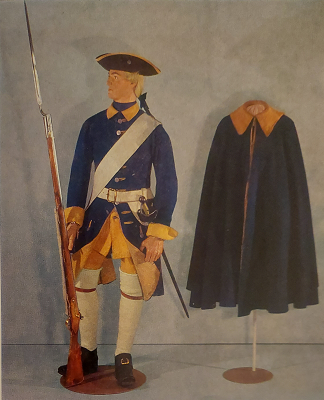
Uniform m/1756 |
The new regime showed little interest in uniforms other
than reducing its costs. The difficult financial situation was not only
caused by the huge war debt it had inherited from Charles XII. The
territorial losses also meant that a very large share of the tax revenue in
the pre-war budget was now gone forever. This loss of tax revenue needed to
be compensated for somewhere else. But all the reforms that Charles XII had
taken in that direction to fund the war effort was rolled back by the new
regime who viewed them as evils of absolutism. So the pre-war tax system
remained in place during the entire period of parliamentary rule with a
permanent structural budget deficit as a result. Foreign subsidies and
temporary taxes had to do to solve any acute crisis, among these two
unnecessary and unsuccessful wars started by the Hat party in 1741 and 1757.
Very little money was thus spent on the military and
uniforms were replaced at longer intervals than before. In addition the
quality of the issued uniforms declined due to widespread corruption during
this time period.
A major uniform regulation was introduced in 1756
although it did not bring any real changes to the uniforms apart from
declaring that all infantry regiments henceforth should have yellow facings.
It was however much more specific than any previous regulation in describing
what the uniform should consist of and how often the items should be
replaced. The coat for example should now be replaced just every twelfth
year. But as always reality was different, the Bohuslän dragoons were still
wearing the coats they had been issued in 1748 when a muster was held in
1767.
It was the experience in Pomerania while fighting the
Prussians 1757-1762 that would bring the end of the Carolean uniform.
Officers complained that it was too difficult to distinguish the different
regiments when they all wore identical uniforms. But it must also have been
a factor that compared to the other armies fighting in that war the Swedish
uniform looked rather plain and old-fashioned. So a new uniform regulation
came into being in 1765 which not only increased the diversity of facings
colours but also changed the style of the coat so that it would resemble the
victorious Prussian army. This uniform was however still a close relative to
the Carolean uniform, though it would in its turn be replaced already in
1779 by a radically different uniform. That was the Gustavian uniform, which
was designed by the fashion interested king Gustav III in a style that was
to be unique for Sweden. But that is a different story.
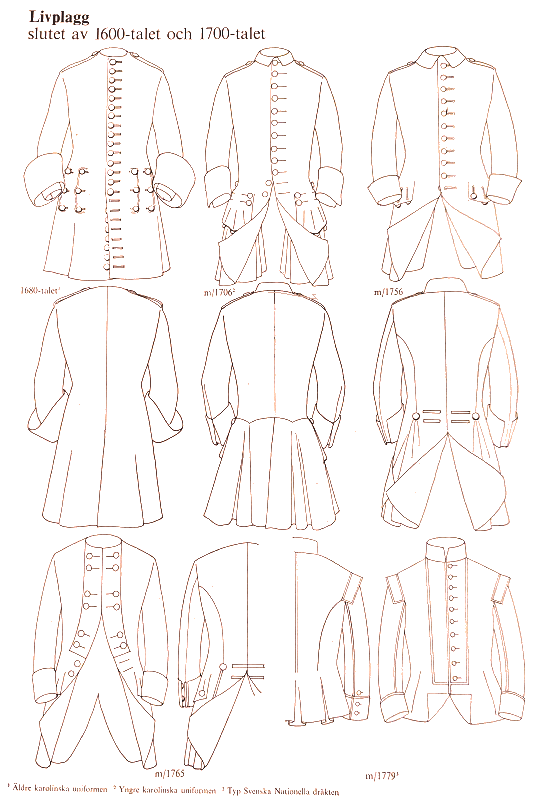
A sketch from Erik Bellander's book (page 565) which shows the various
uniform models of the 18th Century.
-
The so called Older
Carolean uniform which probably
was a prototype and not widely used.
-
The Younger
Carolean uniform, here called
m/1706 but probably looked like the first Carolean
uniforms issued after 1687. The number of
buttons on the pocket flaps should however be three for privates and the
shoulder straps are incorrect. Only the cavalry
appeared to have had shoulder straps in the Great northern War and then
only on one shoulder.
Buttons on the backside near the waist were also present
during this time period.
-
M/1756 which probably was not particularly
different from the earlier uniform.
-
M/1765 which was inspired by Prussia's uniforms
-
The Gustavian
uniform which was designed
by Gustav III himself in
1779.
|

